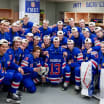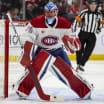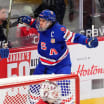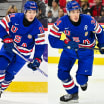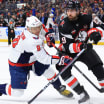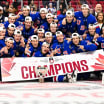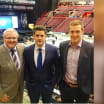Coast Guard Cutters made waves on ice during World War II
Team featuring several top NHL players was star-spangled success

No, it wasn't the Army. Nor was it the Navy. The Air Force? It didn't even exist as a separate entity yet. But the U.S. Coast Guard put together a team that won the National Senior Open Championship of the Amateur Hockey Association twice in their two seasons of play (1942-43 and 1943-44), as well as the Eastern Amateur Hockey League title in 1942-43.
How could tiny Curtis Bay Yard in Baltimore woo such enlistees as future Hockey Hall of Famers Frankie Brimsek and Art Coulter, as well as former NHL forwards Oscar Asmundson and Bud Cook, kid brother of Hall of Famers Bill Cook and Bun Cook of the Rangers? Not to mention a host of other talented players, including Ed Barry, a forward who went on to play with the Boston Bruins, defenseman John Mariucci of the Chicago Black Hawks (then two words), plus many top minor pro stars such as Joe Kucler and Manny Cotlow. Successful minor leaguers such as forwards Ed Olson and Bob Gilray also contributed offensively, and goaltenders Muzz Murray and Hub Nelson shared the net with Brimsek.
The lure was provided by one of the Yard's commanders, Capt. Clifford MacLean, himself an accomplished player turned sailor. Noting that the Baltimore Orioles of the EAHL had folded because they had lost so many players to wartime enlistments, MacLean figured he could fill the void. He spread the word among soon-to-enlist NHL players that a top-flight hockey team was forming and soon had enough talent to form not one but two full teams: the Coast Guard Cutters and the Clippers (who played the Cutters in intrasquad games and exhibitions). Their home rink was Carlin's Iceland in Baltimore. Former NHL referee Mel Harwood also enlisted and was named coach.
"Occasionally," Gilray said, "we'd have exhibition games just between the Cutters and Clippers, and they were as hard-fought as any I ever was in."
Prior to the 1942-43 season, the EAHL was a stepping stone to the NHL and a perfect fit for the newly organized Coast Guard skaters. The Cutters, decked out in red, white and blue star-spangled jerseys with crossed anchors on the front, became an instant sensation thanks to their blend of skill and rambunctious play. They played in the EAHL against teams such as the Philadelphia Falcons, Boston Olympics and New York Rovers.
Famed New York Daily News reporter Dick Young nicknamed them "Hooligan's Navy" because of the presence of rugged players such as Mariucci, who was paired with Cotlow, a big-hitting defenseman from Minnesota.
Mike Nardello, a Rangers prospect from Brooklyn who played for the Rovers, was enthralled by the prospect of skating for the Cutters. Nardello, who later became the penalty timekeeper for the New Jersey Devils, said the Cutters were as good as some NHL teams of that era.
"We had one of the best goalies in NHL history," Nardello said. "Frankie Brimsek was 'Mister Zero' with the Boston Bruins, and now he was puck-stopping for the Cutters. As soon as I could, I joined the Coast Guard."
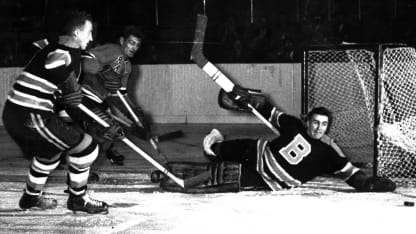
© B Bennett/Getty Images
Playing in big-league buildings such as Madison Square Garden and Boston Garden, the Cutters also entertained fans with a 30-piece band that usually occupied the end arena. Whenever the Cutters would score a goal, the band would burst into a chorus of "Semper Paratus (Always Ready)," the Coast Guard marching song.
Nardello's move from the Rovers to the Coast Guard was one for the books.
"I was going to St. Francis Prep in Brooklyn and also playing for the Rovers," Nardello said. "Eddie Olson of the Cutters encouraged me to join the Coast Guard when I graduated high school and had to be drafted.
"I graduated high school on Jan. 28, 1943. On Sunday, I played for the Rovers at the Garden against the Cutters. A day later, I was sworn into the Coast Guard. Before going to boot camp I got a chance to play one game for the Cutters. It was against the Rovers. In the span of one week I played for and against the Rovers and for and against the Cutters!"
In addition to their EAHL rivals, the Cutters played exhibitions against Canadian service teams sprinkled with NHL players and invariably beat them. The Cutters even challenged the Stanley Cup champion Detroit Red Wings; the teams played in front of a capacity crowd in Baltimore on Jan. 6, 1944. The Cutters hung tough and trailed 4-3 in the third period before running out of gas and losing 8-3.
However, the Cutters wound up being disbanded soon after that. The fighting in the Pacific and European theaters had intensified, and the players started to be called to active duty.
"A lot of parents of servicemen couldn't understand why their sons were overseas fighting and we were playing hockey," Kucler said. "The Coast Guard was under a lot of pressure to break us up, and we began leaving for duty."
The end was in sight one afternoon at Madison Square Garden in March 1944 when an announcement blared over the public-address system while the Cutters were exchanging body checks with the Rovers. Kucler, their leading scorer, was ordered to report for action after the game.
"They said Joe was playing his last game for us and then he would be shipped out," Olsen remembered. "As soon as Joe left they started getting rid of other guys, and by then we knew the honeymoon was over."
Members of the Cutters were assigned to active duty around the world. When the war ended some players, such as Coulter, retired. But Mariucci and Brimsek, among others, returned to the NHL and continued their careers.
On the minor league level, Nardello played at St. Lawrence University, then signed with the Clinton (New York) Comets, one of the best unaffiliated teams just below the NHL level. Others also played minor league hockey.
"I kept wearing my Coast Guard jersey under my Comets sweater," Nardello said. "It always gave me a feeling that those great guys -- Cotlow, Kucler and the rest -- were around for another chorus of 'Semper Paratus.'"



